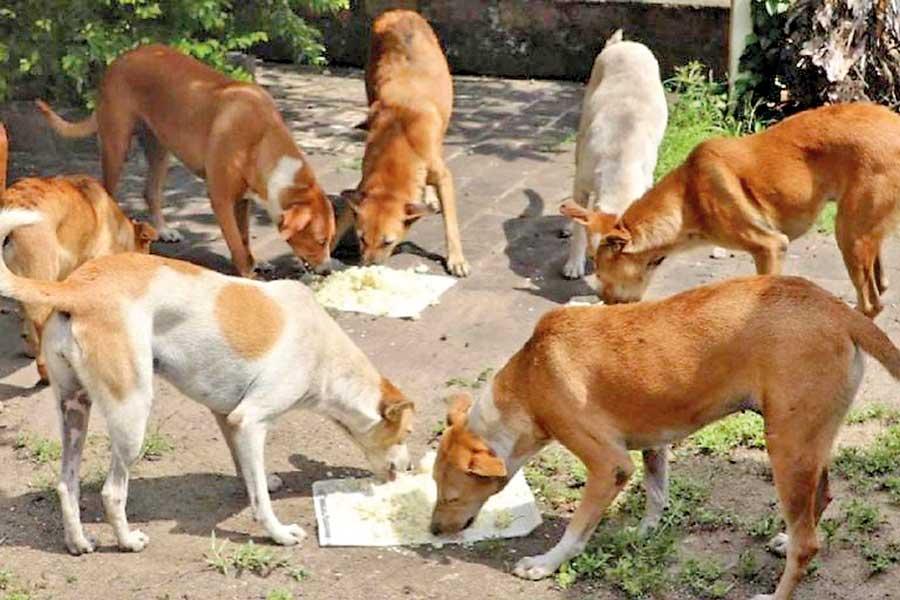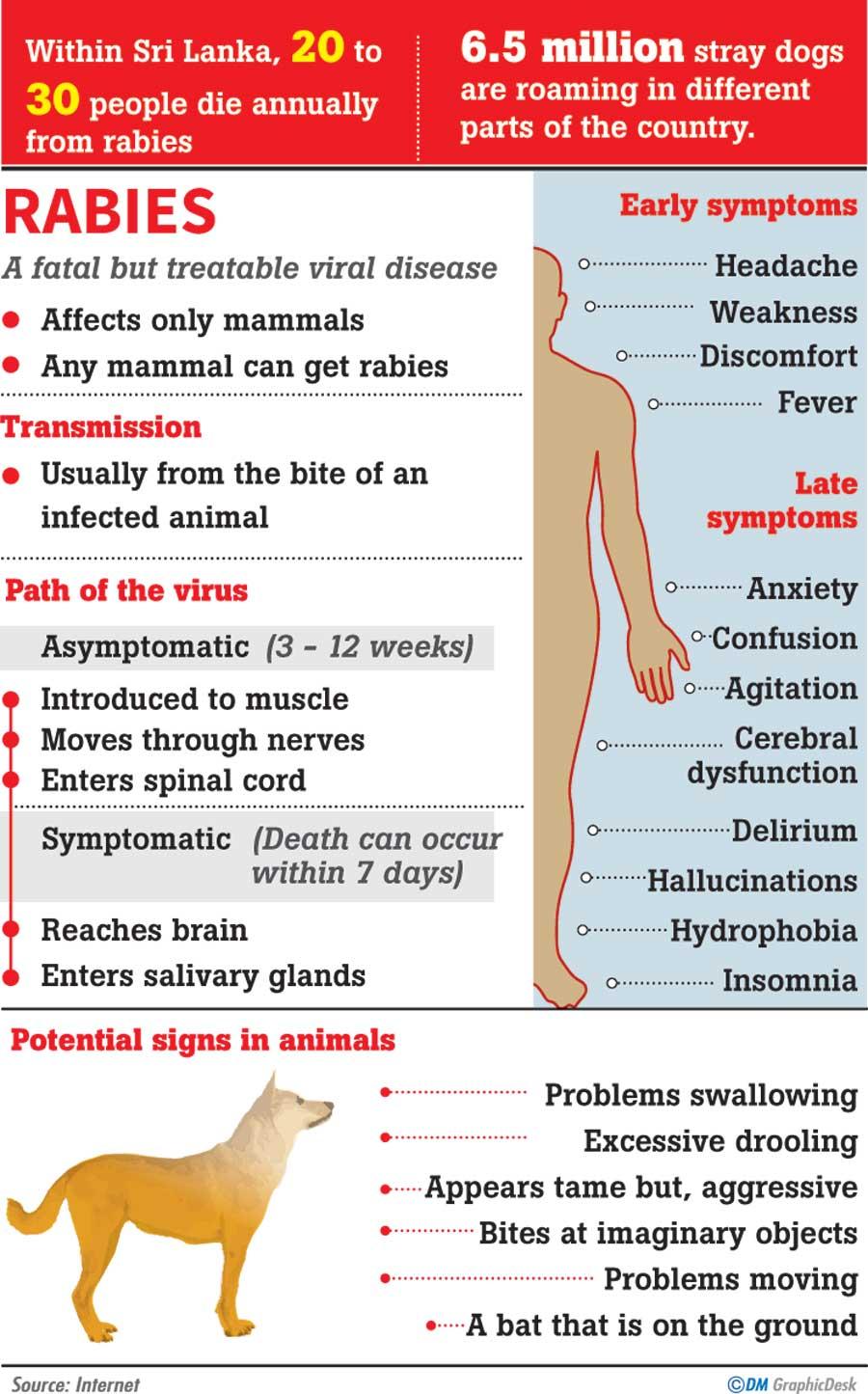05 Apr 2024 - {{hitsCtrl.values.hits}}

Stray dogs roaming around for food
- Roaming dogs in tourist areas such as Sigiriya has caused serious issues
- According to State Minister Pramitha Bandara Tennakoon there are 6.2 million stray dogs in the country
- Public Health Division of the Health Ministry, at present with the help of WHO is planning an island-wide count on dogs
State Minister of Defense Pramitha Bandara Tennakoon said that 6.5 million stray dogs are roaming in different parts of the country. He told the Parliament that this situation has caused serious issues in tourist areas such as Sigiriya. The State Minister said that according to statistics, there are 6.2 million stray dogs in the country and this development has posed serious issues. He said that it is important to find solutions to address this issue as it has posed serious problems in tourist areas as well. Tennakoon said that the government is planning to bring in new Acts to minimise harm to animals. He stressed on the need to find solutions to issues caused by animals before addressing all other issues.
parts of the country. He told the Parliament that this situation has caused serious issues in tourist areas such as Sigiriya. The State Minister said that according to statistics, there are 6.2 million stray dogs in the country and this development has posed serious issues. He said that it is important to find solutions to address this issue as it has posed serious problems in tourist areas as well. Tennakoon said that the government is planning to bring in new Acts to minimise harm to animals. He stressed on the need to find solutions to issues caused by animals before addressing all other issues.
“No one has done any island-wide study on the number of stray dogs except in 3 places in the country covering two districts with isolated data. All these years, the Ministry of Health has been in charge of estimating the number of dogs, the number of stray dogs (ownerless dogs) in relation to the human population, whether it is 5:1, 6:1, or up until 10:1 depending on the human population in that particular area. The Public Health Division of the Health Ministry, at present with the help of WHO (World Health Organization) is planning an island-wide count on dogs, which will be carried out in all districts this year,” said the head of the Department of Veterinary Clinical Science at the University of Peradeniya (UOP) Prof. Ashoka Dangolla.
Prof. Dangolla explained that ownerless dogs need peoples’ affection and attention and not only food and shelter. The dogs deliver puppies twice a year and several infectious sexually transmitted diseases also are spreading among them. Those who like dogs for various reasons take them home, but when puppies are delivered, they keep them on the streets. Various organizations surgically operate on ownerless dogs to stop these animals from delivering puppies. These organizations are paid by the Ministry of Health or find their funding both locally and internationally. Since it is not continuously done, the ownerless dogs appear to increase in number. “Male dogs are not operated on since the budgets are limited. Scientific studies also have shown that the impact of such operations on males is very limited in controlling their numbers. The deadly killer viral disease ‘rabies’ is mostly spread through unvaccinated dogs. Within Sri Lanka, 20 to 30 people die annually from it” added Professor Dangolla. He stated that the Ministry of Health spends much money as in 225 hospitals, people get vaccinated against rabies. They are trying to reduce expenditure while protecting people and reducing the number of ownerless dogs.
Animal rights groups are also paying attention to these situations. “There are fake animal rights groups who keep collecting money. These non-governmental groups have not been focused and implemented according to a plan. Therefore, the impact is limited”, pointed out Prof. Dangolla. “However, dogs breed twice a year. The increasing number can be controlled if they are constantly and vigorously operated on all over the island. Laws have been passed in Sri Lanka regarding this matter, but they haven’t been implemented for 30 years,” said Prof. Dangolla. He mentioned that Colombo and a few other municipality veterinary surgeons are doing an excellent job implementing such laws when handling the responsibility of ownership of dogs. The WHO planned out a strategy for dog-mediated rabies control for Sri Lanka, for which 3 scientists worked together, for the plans mapped out by himself.
Number of stray dogs at tourist attraction places
He explained the issue related to the increased population of stray dogs. Foreigners show compassion toward animals. Therefore, dogs come in the presence of tourists. Further, the dogs are also inquisitive. There are areas where tourists visit frequently and money is generated, but this money earned is not spent for the betterment of that area. No study has been conducted on tourist places regarding dogs. All these depend on what people have observed. “To reduce the population of dogs, necessary programmes should be carried out in every area, it must be done fast, rapidly and continued for several years for anyone to notice an impact while what amounts to responsible dog ownership is taught to people. This doesn’t happen. When money is available, some groups will go and operate on dogs, but soon the money will run out and surgeries stop. Then the numbers go up again,” said Prof. Dangolla. He said that the Public Health Inspectors are specialising in rabies at the district level. In addition, 6 different types of anti-rabies vaccines administered largely to dogs owned by people, are not entered in national-level statistics. Today, it’s largely their responsibility to keep track of such number of dogs, details of their vaccinations (against rabies) and surgeries. After a surgery on a female dog, a small notch on the ear is cut, so that such females can be recognized. These activities are coordinated by the Public Health Veterinary Division of the Ministry of Health. Groups that surgically operate on dogs have been in action for more than a decade now.
Estimation of the dog population
“The number of dogs is estimated by using people: 8:1, every 8 humans have at least 1 dog. This is incorrect and such estimation has been in effect for decades in Sri Lanka,” said Prof. Dangolla. He explained that most dogs on the streets have partial ownership. They go to their owners when they feel hungry. They are called community dogs and they are not stray animals. We must know how many dogs are owned by people, how many are partially owned (not within houses), how many wonder about (with partial ownership), and how many are ownerless. We at present do not know any of these four categories,” the Professor said .
“Male dogs are not operated on since the budgets are limited. Scientific studies also have shown that the impact of such operations on males is very limited in controlling their numbers. The deadly killer viral disease ‘rabies’ is mostly spread through unvaccinated dogs. Within Sri Lanka, 20 to 30 people die annually from it”-Prof. Ashoka Dangolla Head of the Department of Veterinary Clinical Science at the University of Peradeniya (UOP)
Steps that can be taken to decrease the dog population
Prof. Dangolla advocated that responsible ownership must be shown by dog owners. According to him the law of registering dogs must be implemented in which the government plays a major role. He suggests that all activities of non-governmental organizations must be focused, monitored and driven towards one objective by an agency, so that the impact can be measured. He recommends that all veterinary surgeons, who vaccinate dogs and perform surgeries, must register their clinics and their work must be monitored. “The Department of Animal Production and Health has taken some initiative in this regard. They should show lots of positive results in a few years. Dogs are not killed anymore by municipalities,” exclaimed Prof. Dangolla. He underscored that people show more affection towards dogs, but the lack of actions implemented for controlling dogs is low. He also believes that the coordination between the Ministry of Health and the Department of Animal Production and Health must be strengthened to monitor the action that can be done at the district level to decrease the ownerless dog population.
Attacks by animals and the law
According to Prof. Dangolla, the society is the biggest stakeholder in the subject of responsible dog ownership. It is debatable when asking the public not to feed ownerless street dogs, but such action is advisable. Controlling the number of needs of dogs demands a scientific approach. “It is the burden of these dogs that people are worried about. The ownerless dogs do not bite people that much, but ownerless dogs bite people, unless provoked or rabid,” said Prof. Dangolla. He spoke about the law regarding wild mammals, that it must be flexible, so that people with compassion towards such ownerless animals should have the opportunity to bring them to a veterinary surgeon. At present, when a wild animal is spotted, being injured, orphaned or wounded, people are reluctant to attend to them due to stringent laws and its implementation. However, he also wished to indicate that Sri Lankans show compassion towards animals.
Are animals affected by the temperature?
He mentioned that the increased temperature would certainly change animal behaviour. Most animals become uneasy and can be easily disturbed and therefore, get agitated for the slightest thing. Further, he explained that animal bites are observed to be more frequent in warmer areas compared to cooler areas. “This has not been properly analysed and documented though. There are just observations,” said Prof. Dangolla. He proposed a method that if hospitals can record details of animal bites separately in a separate register this can be done.
Vaccination process
Prof. Dangolla explained that the Ministry of Health had been conducting dog rabies vaccination at predetermined places and dates in every single village in the country. He said that whenever a rabid dog is reported, the Ministry of Health through PHI, (Public Health Inspector) vaccinates dogs in the area. All this reminds people of the role of Local Government, which he said is not played by the authorities. Moreover, he spoke of a solution which is to capture suspected dogs and manage and monitor them for the betterment of the society. “This does not happen in most places. In addition, there are 6 different market brands of anti rabies vaccines imported by private companies and administered to dogs via veterinary surgeons. This data is not included in statistics. This has been the case for decades. This shows that the data available within the country is largely improper and incorrect,” exclaimed Prof. Dangolla. He explained that actions have been taken by the Department of Animal Production and Health to register all veterinary clinics and therefore, this can be monitored.
“If anti-rabies is administered by the Health Ministry, it is considered not to be inferior. Cold chain maintenance is done properly and it is a good quality vaccine. Cold Chain Management is when the vaccines are maintained within the recommended temperatures. The Ministry of Health always checks information and selects the vaccine to be imported,” he said.
He concluded that the Ministry of Health is doing an excellent job by vaccinating dogs against rabies and protecting dog-bitten people via vaccinating such individuals. The contributions in this regard by veterinary surgeons spread throughout the country. Moreover, he said these will improve with time and steps have been taken in that regard. Several NGOs are also working, but their work is not focused and coordinated. Their contributions are important and must be quantified.
“If people want to get treatment for their dogs they can ring us on our hotline and they will be provided with free treatment. We have the capacity of providing medical treatment to about 60 dogs at Kurunegala. Once we lose capacity the one who brings the dog will have to take care of him temporarily”-
Gihan Dinushka Founder of ‘Baw Baw’
Role of Animal Welfare Organizations
‘Baw Baw’ is an Animal Welfare dedicated to improving Animal Welfare in Sri Lanka. The founder of this organization Gihan Dinushka explained that this organization has been funded by their members. “We have another platform constructed for the adoption of stray dogs. After rescuing them, we also search for houses for the stray dogs,” said Dinushka. He mentioned that (adapting) is not a practical solution to decrease the stray dog population. As a solution for this increased population of stray dogs sterilization is a good solution to put into practice, explained Dinushka. “It is a random count that has been taken at the parliament and no authority has counted the population of dogs to give an exact count,” said Dinushka. We assume that there is a ratio of 8:1 between the human and dog population. On a final count, it would be around 2.5 million.
“If people want to get treatment for their dogs they can ring us on our hotline and they will be provided with free treatment. We have the capacity of providing medical treatment to about 60 dogs at Kurunegala. Once we lose capacity the one who brings the dog will have to take care of him temporarily,” explained Dinushka. He complained that the Government of Sri Lanka interferes on this issue due to the absence of continuous actions taken to keep the stray dog count low. It was said that it is the citizens’ duty to deal with the dogs and take the necessary steps, such as get the animals operated, to avoid more breeding in the community. Dinushka pointed out that there is no correct follow up in the injections given to the stray dogs to stop preventing rabies. “Rabies is a vaccination that should be given once every year on a specific date, but this is not practiced on date by the Municipal Councils. There are dogs that are affected by rabies in areas where the vaccine was injected. This should be further monitored,” explained Dinushka.
At present, there are actions taken by various institutions to reduce the population of stray dogs and the spread of rabies. The students of the faculty of Veterinary Medicine & Animal Science at University of Peradeniya have created a welfare community to help in treating the injured stray dogs and vaccinating them against rabies.

29 Dec 2024 1 hours ago
29 Dec 2024 4 hours ago
29 Dec 2024 4 hours ago
29 Dec 2024 5 hours ago
29 Dec 2024 7 hours ago